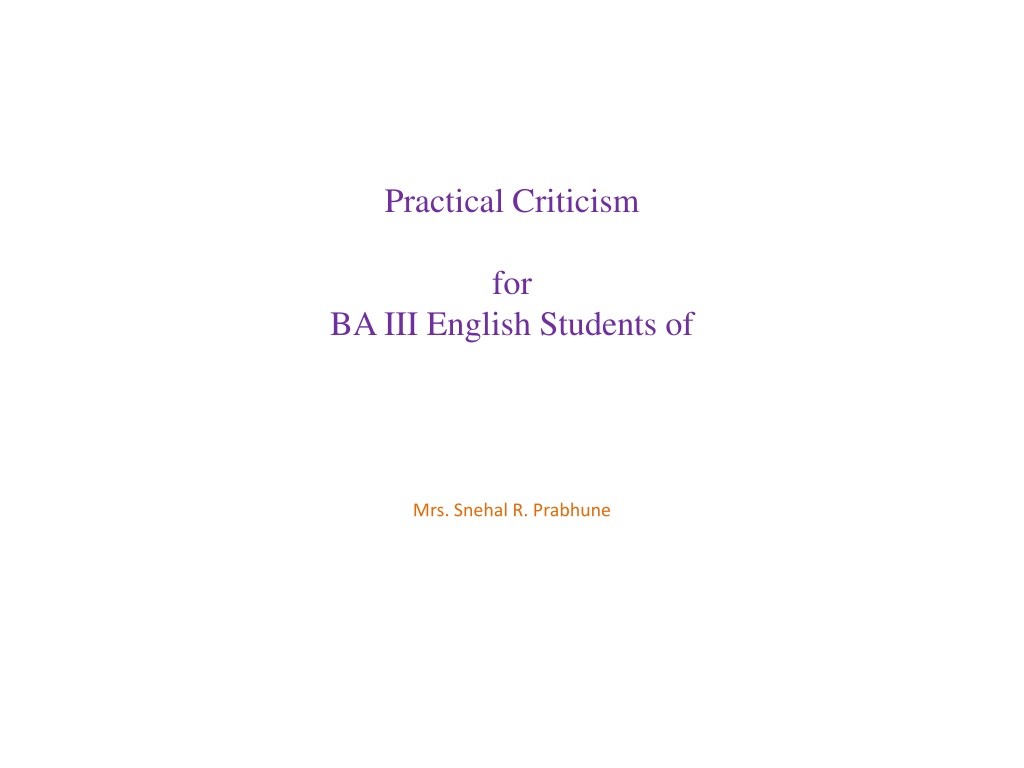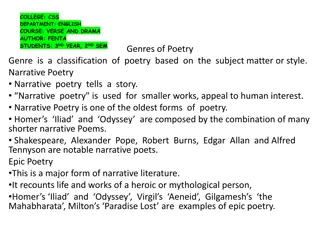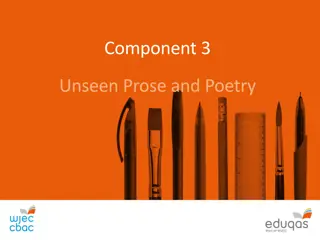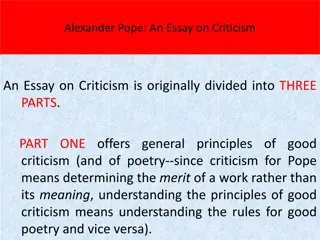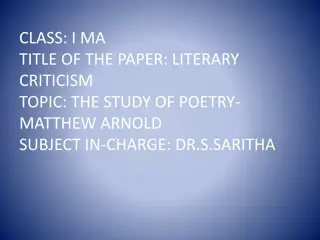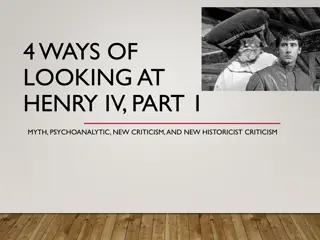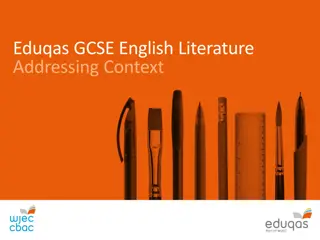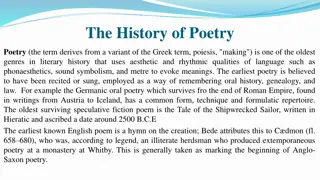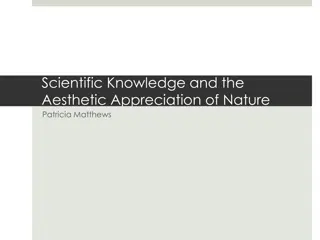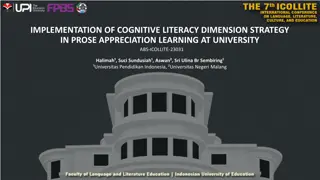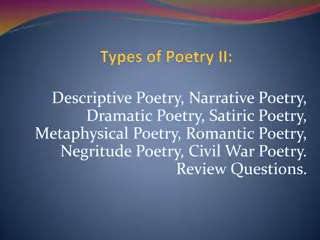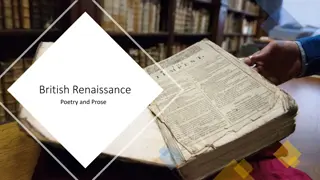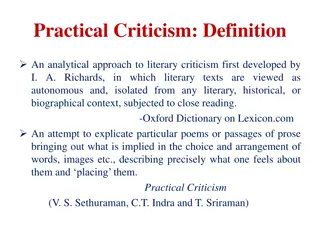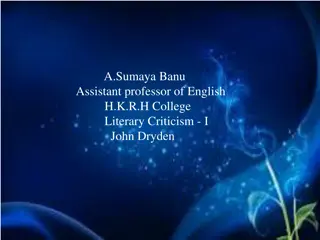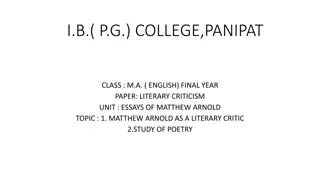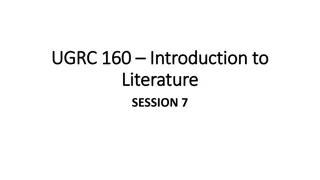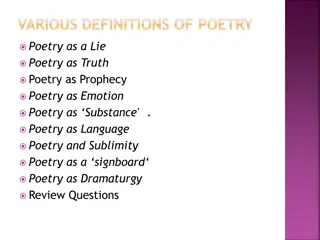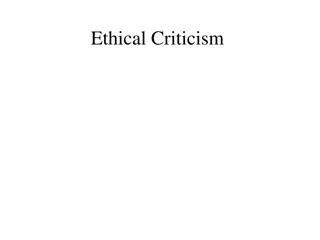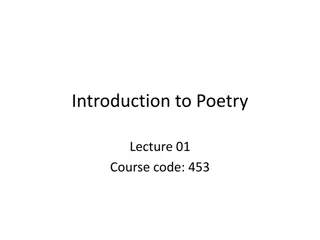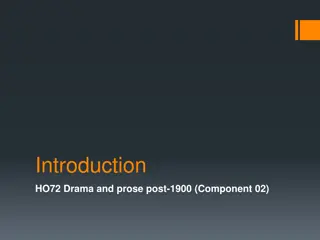Practical Criticism: Analysis and Appreciation of Poetry and Prose
Delve into the world of practical criticism and critical appreciation in BA III English studies with a focus on analyzing and appreciating poetry and prose. Explore the history, significance, and methodology behind this literary practice while gaining insights into interpreting unseen poems. Discover how to dissect themes, structures, tones, and literary devices in poems while formulating personal impressions and comments in a critical appreciation.
Download Presentation

Please find below an Image/Link to download the presentation.
The content on the website is provided AS IS for your information and personal use only. It may not be sold, licensed, or shared on other websites without obtaining consent from the author. Download presentation by click this link. If you encounter any issues during the download, it is possible that the publisher has removed the file from their server.
E N D
Presentation Transcript
Practical Criticism for BA III English Students of Mrs. Snehal R. Prabhune
Practical Criticism Also called Applied Criticism or Critical appreciation of a poem or prose passage Concept: Analysis of the given poem or prose passage with respect to its: Subject Content Structure Tone Imagery Verbal felicity Rhythm Metre Figures of Speech
History and Significance I A Richards Practical Criticism (1929) explains the need for Practical Criticism New Critics in America popularized the concept through the theory of close reading Significance: A lively experience Helps to identify the sources yielding pleasure in a given text Students need to answer a question in their paper on criticism on this topic
Appreciation of Unseen Poem Questions below the poem should be used only as hints or help in appreciating the poem. Appreciation should be in the form of continuous prose in the form of paragraphs.
Plan of a Critical Appreciation Three Parts: 1. What 2. How 3. Personal Impression/ Comments/ Summing up
First Part: What Answers to questions like, What is------ the theme of the poem general meaning intention of the poet mood of the poem type of the poem special lyrical type if any comment on the period or literary age of the poem if part of British, American, African, Indian literature etc.
Second Part: How This part discusses the use of various devices by the poet i.e. how the poet has conveyed the what of in the poem. Devices are of three types: 1. Structural devices-Contrast -Illustration -Repetition 2. Sense devices-Simile, Metaphor and all figures of speech 3. Sound devices-rhythm, rhyme, alliteration, assonance, consonance, onomatopoeia etc.
Second Part contd. While writing about these devices one paragraph for each type of devices is sufficient. Regarding figures of speech and sound devices it is not just enough to locate their use; they should be explained, their significance brought out. Use of inversion or foregrounding if any also has to be explained
Third Part This part sums up whatever has gone before. Your impressions about the poem or its effect on you be stated Any comments on the poem in short
Some terms clarified Types of poems- Descriptive, Narrative and Reflective (sometimes a poem may be a combination of two types also) Mood could be light or serious Lyrical type: sonnet, elegy, ballad, ode, dramatic monologue, idyll etc. Age/ Period/ School: Renaissance or Shakespearean, Metaphysical, Neo-classical, Romantic, Modern etc. Indian/ American/ British/ Australian/ African/ Carribean/ Canadian etc (if possible) Intention: See if there is any hiden meaning
Structural Devices Contrast: The idea or object intended to highlight is contrasted with an opposite idea or object. e.g. In Blake s Tyger there is a line: Did he make the lamb Make thee? Illustration: The idea that the poet intends to emphasize is explained with an example. e.g. In Wordswoth s Daffodils the poet emphasizes the huge number of the flowers by saying: ten thousands saw at a glance , a host of golden daffodils Repetition: A poet repeats an idea in two or more stanzas in order to highlight it. e.g. Superiority of old age is emphasized by enumerating the benefits of old age.
Sense Devices Simile Metaphor Personification Antithesis, Oxymoron Hyperbole Synecdoche Metonymy Irony/Paradox
Sound Devices Rhyme Rhythm (metres) Alliteration Consonance Assonance Repetition/ Refrain Onomatopoeia
Rhyme Perfect rhymes/ Full Rhymes Rime Riche- same spelling/ words, but different meanings in the two cases Masculine Rhyme-only final stressed syllable rhymes e.g. bad and mad Feminine Rhyme-final two syllables of which final syllable is unstressed rhyme e.g. pester and fester Triple Rhyme- three syllables rhyme, but is quite unusual e.g. revision and division Para rhyme/Half rhyme- opening and closing consonants of the rhyming words are same but the middle vowel is different e.g. hall and hell
Effects of Rhyme Contribute to the poetic structure Musical , hence pleasing Easily noticed, gets prominence and thus carries important ideas Can bea guide to the poem s meaning
Rhythm/ Metres/ Prosody Prosody is the study of the metrical pattern of a poem to understand the poetic effects. Scansion is division of words into syllables and determining whether they are stressed or unstressed and thereby deciding the metre used. Syllable- the smallest unit of metrics- any word or part of a word that contains a single voiced vowel or a diphthong with or without any marginal element (consonant). Thus one voiced vowel= one syllable. Monosyllabic word go, taught sea Disyllabic words- tonight, water, Bruno Trisyllabic / polysyllabic words-property, emphasis
Determining Metre 1ststep-find the average number of syllables in a line e.g. Tell /me/ not/ in/ mourn/ful/ num/bers About 60-80% words in English poetry are monosyllabic 2ndstep divide the syllables into stressed and unstressed ones A syllable that is emphasized/ pronounced more forcefully/ carries more weight is stressed and is denoted by a or / whereas an unstressed syllable is denoted by a or x Usually syllables take the stress as per the dictionary or as in regular speech but poets sometimes vary the stress in case of monosyllabic words. / x x / wa/ter a /lone
Metres Contd. 3rdstep: Once the stresses are marked the line can be divided into smaller units with equal number of syllables called feet (singular= foot).A foot consists of two or more stressed or unstressed syllables. Basic Metres in English: 1. Iambic foot (x /): one unstressed followed by a stressed 2. Trochaic foot (/ x); one stressed followed by an unstressed 3. Anapaestic foot (xx/) : two unstressed followed by a stressed 4. Dactyllic foot (/xx): one stressed followed by two unstressed
Metres Contd. Supplementary Metres: Spondee (/ /): two stressed syllables Pyrrhic (x x): Two unstressed syllables Amphibrach (x / x): one stressed syllable between two unstressed syllables Based on the number of times a foot is repeated in a line the base metre of the line is determined. e.g. iambic dimetre, iambic trimetre, tetrameter, pentameter etc. Iambic pentameter is the most common metre in English poetry Effect of Metre:Affects the mood of the poem
